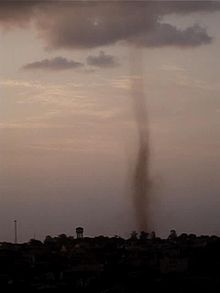
Back Tornade#Trombes terrestres French Nem-mezociklonális tornádó Hungarian Windhoos Dutch Landspout Portuguese 陸龍捲 Chinese



| Part of a series on |
| Weather |
|---|
|
|
Landspout is a term created by atmospheric scientist Howard B. Bluestein in 1985 for a tornado not associated with a mesocyclone.[3] The Glossary of Meteorology defines a landspout:
- "Colloquial expression describing tornadoes occurring with a parent cloud in its growth stage and with its vorticity originating in the boundary layer.
- The parent cloud does not contain a preexisting mid-level mesocyclone. The landspout was so named because it looks like "a weak Florida Keys waterspout over land."[4]
Landspouts are typically weaker than mesocyclone-associated tornadoes spawned within supercell thunderstorms, in which the strongest tornadoes form.
- ^ Judson Jones (21 May 2020). "Why Landspout Tornadoes are Common in Colorado". The Denver Post.
- ^ Cite error: The named reference
CNNwas invoked but never defined (see the help page). - ^ Bluestein, Howard B. (1985). "A History of Severe-Storm-Intercept Field Programs". Weather and Forecasting. 14 (4): 267–270. Bibcode:1999WtFor..14..558B. doi:10.1175/1520-0434(1999)014<0558:AHOSSI>2.0.CO;2. ISSN 1520-0434.
- ^ American Meteorological Society (2000). "Glossary of Meteorology, Second Edition". ametsoc.org. Archived from the original on 6 April 2007. Retrieved 27 March 2007.